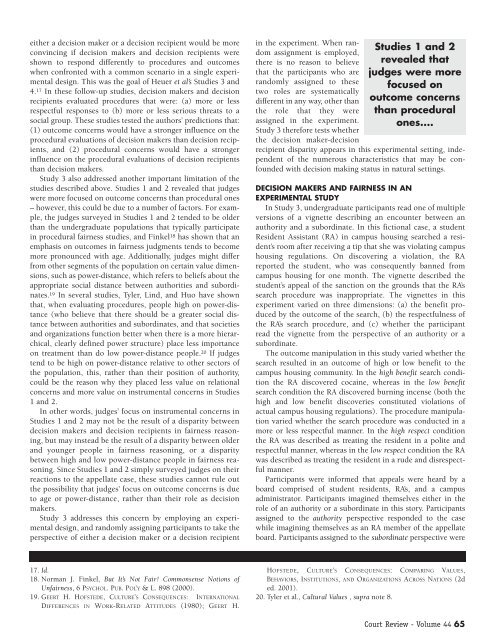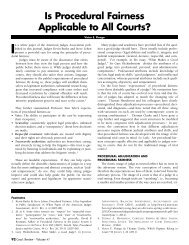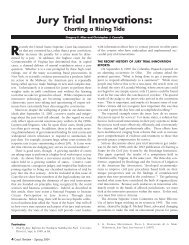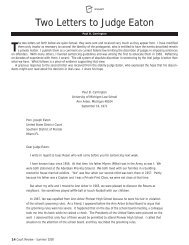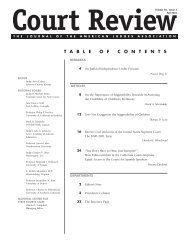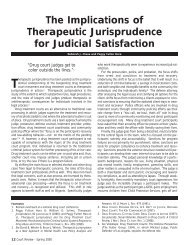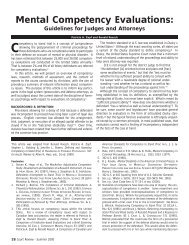Special Issue on Procedural Fairness - American Judges Association
Special Issue on Procedural Fairness - American Judges Association
Special Issue on Procedural Fairness - American Judges Association
- No tags were found...
You also want an ePaper? Increase the reach of your titles
YUMPU automatically turns print PDFs into web optimized ePapers that Google loves.
either a decisi<strong>on</strong> maker or a decisi<strong>on</strong> recipient would be morec<strong>on</strong>vincing if decisi<strong>on</strong> makers and decisi<strong>on</strong> recipients wereshown to resp<strong>on</strong>d differently to procedures and outcomeswhen c<strong>on</strong>fr<strong>on</strong>ted with a comm<strong>on</strong> scenario in a single experimentaldesign. This was the goal of Heuer et al’s Studies 3 and4. 17 In these follow-up studies, decisi<strong>on</strong> makers and decisi<strong>on</strong>recipients evaluated procedures that were: (a) more or lessrespectful resp<strong>on</strong>ses to (b) more or less serious threats to asocial group. These studies tested the authors’ predicti<strong>on</strong>s that:(1) outcome c<strong>on</strong>cerns would have a str<strong>on</strong>ger influence <strong>on</strong> theprocedural evaluati<strong>on</strong>s of decisi<strong>on</strong> makers than decisi<strong>on</strong> recipients,and (2) procedural c<strong>on</strong>cerns would have a str<strong>on</strong>gerinfluence <strong>on</strong> the procedural evaluati<strong>on</strong>s of decisi<strong>on</strong> recipientsthan decisi<strong>on</strong> makers.Study 3 also addressed another important limitati<strong>on</strong> of thestudies described above. Studies 1 and 2 revealed that judgeswere more focused <strong>on</strong> outcome c<strong>on</strong>cerns than procedural <strong>on</strong>es– however, this could be due to a number of factors. For example,the judges surveyed in Studies 1 and 2 tended to be olderthan the undergraduate populati<strong>on</strong>s that typically participatein procedural fairness studies, and Finkel 18 has shown that anemphasis <strong>on</strong> outcomes in fairness judgments tends to becomemore pr<strong>on</strong>ounced with age. Additi<strong>on</strong>ally, judges might differfrom other segments of the populati<strong>on</strong> <strong>on</strong> certain value dimensi<strong>on</strong>s,such as power-distance, which refers to beliefs about theappropriate social distance between authorities and subordinates.19 In several studies, Tyler, Lind, and Huo have shownthat, when evaluating procedures, people high <strong>on</strong> power-distance(who believe that there should be a greater social distancebetween authorities and subordinates, and that societiesand organizati<strong>on</strong>s functi<strong>on</strong> better when there is a more hierarchical,clearly defined power structure) place less importance<strong>on</strong> treatment than do low power-distance people. 20 If judgestend to be high <strong>on</strong> power-distance relative to other sectors ofthe populati<strong>on</strong>, this, rather than their positi<strong>on</strong> of authority,could be the reas<strong>on</strong> why they placed less value <strong>on</strong> relati<strong>on</strong>alc<strong>on</strong>cerns and more value <strong>on</strong> instrumental c<strong>on</strong>cerns in Studies1 and 2.In other words, judges’ focus <strong>on</strong> instrumental c<strong>on</strong>cerns inStudies 1 and 2 may not be the result of a disparity betweendecisi<strong>on</strong> makers and decisi<strong>on</strong> recipients in fairness reas<strong>on</strong>ing,but may instead be the result of a disparity between olderand younger people in fairness reas<strong>on</strong>ing, or a disparitybetween high and low power-distance people in fairness reas<strong>on</strong>ing.Since Studies 1 and 2 simply surveyed judges <strong>on</strong> theirreacti<strong>on</strong>s to the appellate case, these studies cannot rule outthe possibility that judges’ focus <strong>on</strong> outcome c<strong>on</strong>cerns is dueto age or power-distance, rather than their role as decisi<strong>on</strong>makers.Study 3 addresses this c<strong>on</strong>cern by employing an experimentaldesign, and randomly assigning participants to take theperspective of either a decisi<strong>on</strong> maker or a decisi<strong>on</strong> recipientin the experiment. When randomassignment is employed,there is no reas<strong>on</strong> to believethat the participants who arerandomly assigned to thesetwo roles are systematicallydifferent in any way, other thanthe role that they wereassigned in the experiment.Study 3 therefore tests whetherthe decisi<strong>on</strong> maker-decisi<strong>on</strong>Studies 1 and 2revealed thatjudges were morefocused <strong>on</strong>outcome c<strong>on</strong>cernsthan procedural<strong>on</strong>es....recipient disparity appears in this experimental setting, independentof the numerous characteristics that may be c<strong>on</strong>foundedwith decisi<strong>on</strong> making status in natural settings.DECISION MAKERS AND FAIRNESS IN ANEXPERIMENTAL STUDYIn Study 3, undergraduate participants read <strong>on</strong>e of multipleversi<strong>on</strong>s of a vignette describing an encounter between anauthority and a subordinate. In this ficti<strong>on</strong>al case, a studentResident Assistant (RA) in campus housing searched a resident’sroom after receiving a tip that she was violating campushousing regulati<strong>on</strong>s. On discovering a violati<strong>on</strong>, the RAreported the student, who was c<strong>on</strong>sequently banned fromcampus housing for <strong>on</strong>e m<strong>on</strong>th. The vignette described thestudent’s appeal of the sancti<strong>on</strong> <strong>on</strong> the grounds that the RA’ssearch procedure was inappropriate. The vignettes in thisexperiment varied <strong>on</strong> three dimensi<strong>on</strong>s: (a) the benefit producedby the outcome of the search, (b) the respectfulness ofthe RA’s search procedure, and (c) whether the participantread the vignette from the perspective of an authority or asubordinate.The outcome manipulati<strong>on</strong> in this study varied whether thesearch resulted in an outcome of high or low benefit to thecampus housing community. In the high benefit search c<strong>on</strong>diti<strong>on</strong>the RA discovered cocaine, whereas in the low benefitsearch c<strong>on</strong>diti<strong>on</strong> the RA discovered burning incense (both thehigh and low benefit discoveries c<strong>on</strong>stituted violati<strong>on</strong>s ofactual campus housing regulati<strong>on</strong>s). The procedure manipulati<strong>on</strong>varied whether the search procedure was c<strong>on</strong>ducted in amore or less respectful manner. In the high respect c<strong>on</strong>diti<strong>on</strong>the RA was described as treating the resident in a polite andrespectful manner, whereas in the low respect c<strong>on</strong>diti<strong>on</strong> the RAwas described as treating the resident in a rude and disrespectfulmanner.Participants were informed that appeals were heard by aboard comprised of student residents, RA’s, and a campusadministrator. Participants imagined themselves either in therole of an authority or a subordinate in this story. Participantsassigned to the authority perspective resp<strong>on</strong>ded to the casewhile imagining themselves as an RA member of the appellateboard. Participants assigned to the subordinate perspective were17. Id.18. Norman J. Finkel, But It’s Not Fair! Comm<strong>on</strong>sense Noti<strong>on</strong>s ofUnfairness, 6 PSYCHOL. PUB. POL’Y & L. 898 (2000).19. GEERT H. HOFSTEDE, CULTURE’S CONSEQUENCES: INTERNATIONALDIFFERENCES IN WORK-RELATED ATTITUDES (1980); GEERT H.HOFSTEDE, CULTURE’S CONSEQUENCES: COMPARING VALUES,BEHAVIORS, INSTITUTIONS, AND ORGANIZATIONS ACROSS NATIONS (2ded. 2001).20. Tyler et al., Cultural Values , supra note 8.Court Review - Volume 44 65


